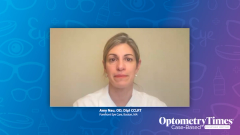
Strategies for Diagnosing and Treating Demodex
Dr Amy Nau outlines her comprehensive strategy for addressing Demodex infestations and explains how she combines therapies to manage multifactorial dry eye disease.
This is a video synopsis of a discussion involving Amy Nau, OD, Dipl CCLRT. In this segment, she shares strategies for diagnosing and managing patients with demodex infestation, a prevalent condition affecting approximately 60 to 70% of her patients. Dr. Nau emphasizes the importance of a thorough examination by having patients look down while lifting the lids to examine the base of the eyelashes under high magnification.
When the demodex mite count exceeds five per lid, Dr. Nau recommends treatment. Initial interventions involve simple and cost-effective measures such as tea tree shampoo, q-tip application, and warm compresses. If these prove insufficient after six to eight weeks, microblepharoexfoliation, possibly combined with IPL (intense pulsed light), is considered.
Dr. Nau expresses excitement about the availability of pharmaceutical options for demodex treatment, highlighting the significant motivation among patients to address the condition upon visual confirmation. Unlike traditional dry eye cases, patients with demodex are often more proactive in adhering to prescribed therapies due to the visual evidence of mite infestation.
This discussion underscores the simplicity of diagnosing demodex and the evolving pharmaceutical options that enhance the ability to effectively treat patients with this condition. Dr. Nau's insights provide valuable perspectives on diagnosing and managing demodex, offering hope for improved adherence and successful treatment outcomes.
Video synopsis is AI-generated and reviewed by Optometry Times® editorial staff.
Newsletter
Want more insights like this? Subscribe to Optometry Times and get clinical pearls and practice tips delivered straight to your inbox.










































